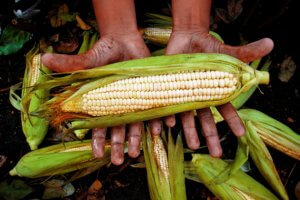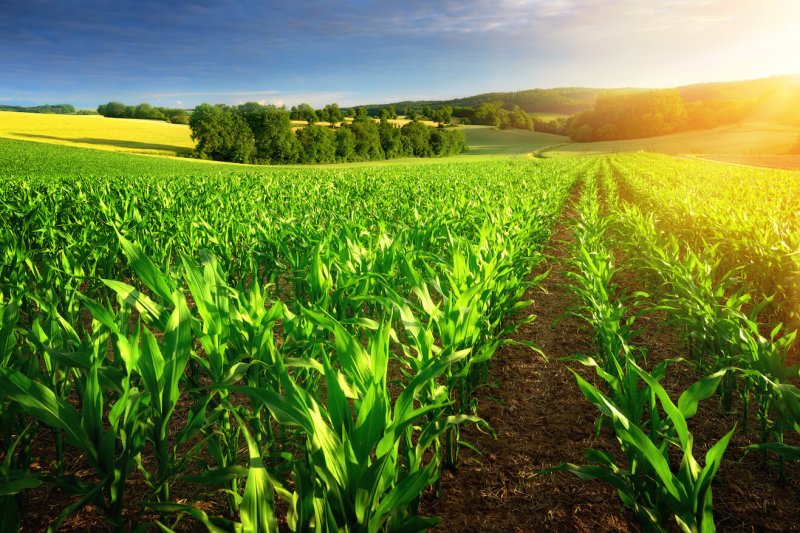There are basically two ways to reduce agriculture’s impact on climate: decrease the sources of carbon, or increase the sinking of carbon (plants sequestering key compounds). New varieties of plants and animals will have to tolerate abiotic stresses like drought, salt and temperature increases, while at the same time improving yields and nutrition.
Genetic modifications (including transgenics and gene editing) are contributing research at the least toward this goal, but some conventional farming, “agroecology,” “regenerative ag” and even organic projects are in the works as well.
Genetic engineering
- Wheat and barley, when subjected to heat and drought, reduced grain size and expression of genes for starch production. “Transgenic approaches have also been shown to improve drought tolerance under controlled environmental conditions,” wrote Kathleen Hefferon, plant genetics researcher at Cornell University. These approaches include over-expressed DREB (dehydration responsive element binding) genes that can boost survival under these conditions. However, no field condition tests have been conducted yet that show “real-life” crop performance.
- The wild barley Hordeum brevisubulatum, which prefers salty environments in Asia and Eastern Europe, has a transcription activation gene (HbMBG1a) that enhances salt tolerance in the common mustard plant, Arabidopsis thaliana. In other work, the same DREB gene used to enhance drought tolerance also boosted salt tolerance in soybean plants when over-expressed.
- Improving photosynthesis via genetic engineering “can be used to make plants more productive, under heat stress conditions anticipated by climate change, especially since improvements using traditional breeding methods have reached their limits,” Hefferon added. One approach is to use enzymes from algae to increase the intake of carbon (sequestration) and introduce a more efficient “C4” photosynthetic pathway into “C3” plants. This could enhance photosynthesis by 40 percent.
Genome editing
Genome editing (via CRISPR-Cas9, among other methods like TALENS or ZFN) is also being used to develop products that address impacts of climate change. In an interview with Genetic Engineering and Biotechnology News, Oliver Peoples, CEO of Yield10 Bioscience, said the company is field testing two traits, C3014 and C3015, in oilseeds to produce polyhydroxyalkanoates (PHAs), a biodegradable plastic product. The Camelina oilseed plant, with the help of gene editing, could produce PHAs to substitute for plastic utensils, straws and packaging material.

The same abiotic stresses that were addressed by transgenics also could be resolved through gene editing techniques. One study showed that by using CRISPR-Cas9 to knock out the MAP kinase gene SlMAPK in tomatoes, the resulting products could resist heat stress. Another study showed that CRISPR created variants of a ARGOS8 gene in corn that could increase crop yields in drought conditions. CRISPR also is opening the door to crops with a better nutritional profile, to provide nitrogen more efficiently, reduce food waste and prevent methane emissions. New breeding techniques (CRISPR, in particular) are poised to fundamentally change how crop and livestock development is done.
Regenerative ag/agro-ecology
Part of the 2020 presidential campaign involved invocation of “regenerative agriculture,” and occasionally “agroecology.” Practices in agroecology or regenerative agriculture could be useful if they make sense scientifically. But, as Hefferon and Henry Miller, founder of the FDA’s Office of Biotechnology, wrote in the Bakersfield Californian, excess baggage of social change and overemphasis on organic labels won’t help truly resolve farming’s climate footprint:
The study of agroecology has numerous definitions, many of which are idealistic blather and conjecture, much of which should be discarded,” they wrote. “Where agroecology breaks down is in its embrace of organic agricultural practices, which fails the test of rigorous science.

One part of regenerative agriculture involves using more sophisticated digital technologies to analyze fields and crops. Sensors and computer imaging “let us identify highly precise spraying areas by considering smaller units, making it possible to manage variability within a field and allow for nuanced application of products and monitoring of crops,” wrote Erik Fyrwald, CEO of Syngenta Group. “Massive amounts of data can be analyzed to create a power seed selection algorithm, helping farmers determine which seeds to plant, and where and how deep to plant them.”
Another effort involves decades of deforestation in Central American mountain regions to make room for coffee and cattle. Eric Poncon, regional director for the coffee division of Ecom Agroindustrial Corp., and Juan Diego Roman, agronomist with Nespresso, profiled the La Cumplida Coffee Farm in Nicaragua, which is restoring shade-grown coffee farms, which can conserve forests and sequester more carbon. It will also offer more shelter to wintering migratory warblers. Key to the effort, they added, is the introduction of standardized, measurable metrics to document their progress.
Non-genetic advances
Nitrogen is a precious ingredient in fertilizer, made more so because conventional processes involve the Haber-Bosch method. This method of making ammonia from airborne nitrogen is energy and carbon intensive, and financially out of the developing world’s reach. Atmonia, based in Reykjavík, Iceland, creates ammonia through electro chemistry, creating ammonia in water without expensive high temperatures and pressure.
A number of agribusinesses, including Bayer and Novozymes are looking at naturally occurring microbes that might result in a “probiotic cocktail.” According to a report in Chemical and Engineering News, “helpful microorganisms colonize soils, plant roots, stems and leaves, making nutrients from the environment available to plants by fixing nitrogen from the air and breaking down inorganic phosphates in soil.”
Organic
The key challenge for organic techniques is increasing yield, so that less land will be turned over for farming (the same applies to conventional agriculture). The USDA has supported research in improving nitrogen use and increasing yields, including:
- A Montana State University project to look at the effects of replacing tillage (which emits carbon) with targeted sheep grazing. “Our transformative extension activities will enhance producers’ ability to make informed management decisions about integrated crop-livestock organic systems,” the study reported.
- A University of Illinois study to use information systems to more precisely determine organic farm inputs. “By initializing simplified models with indicators of soil quality, and training farmers to record information about key drivers (cover crop and manure quantity and composition and soil moisture), we should be able to make associated decision support tools more accurate and provide users with enough detail to implement sound nutrient management and emissions reduction strategies,” the study leaders wrote.
However, organic systems may not be able to match conventional yields, at least not using the current definition of “organic,” which precludes the use of transgenics, cisgenics or gene editing. University of Goettingen’s Matin Qaim and his colleague Eva-Marie Meemken warned in a 2018 Annual Review of Resources Economics article:
In terms of environmental and climate change effects, organic farming is less polluting than conventional farming when measured per unit of land but not when measured per unit of output.
Organic farming is not the paradigm for sustainable agriculture and food security, but smart combinations of organic and conventional methods could contribute toward sustainable productivity increases in global agriculture.
Andrew Porterfield is a senior correspondent for the Genetic Literacy Project. He is a writer and editor, and has worked with numerous academic institutions, companies and non-profits in the life sciences. BIO. Follow him on Twitter @AMPorterfield































